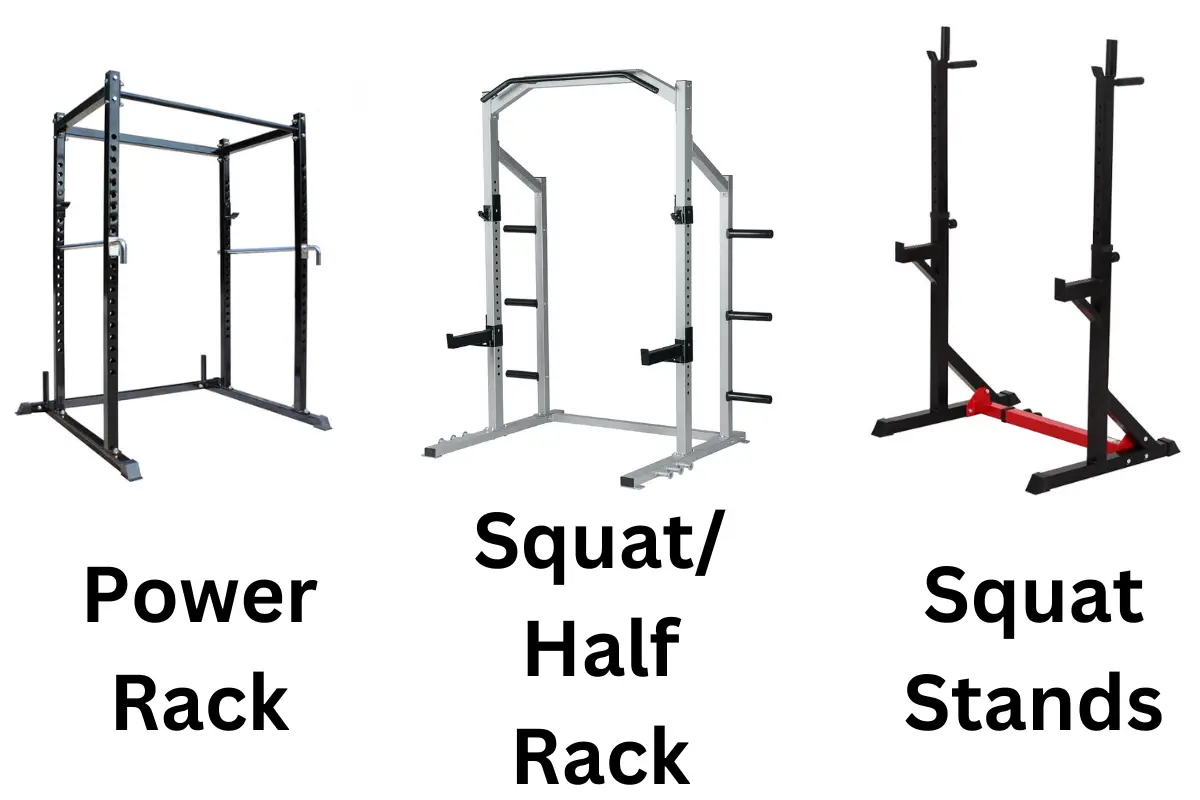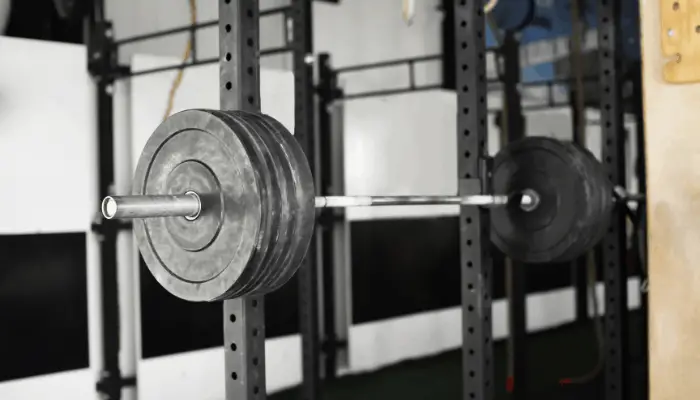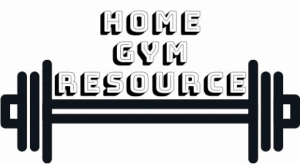How heavy is a power rack or squat rack? You might want to know before buying one to figure out where and how you can place it. I’ve done a lot of searching and compiled a list of 47 popular home gym racks and how much they weigh. Here are the results.
A full-size squat rack weighs about 195 on average. Models with 3″x 3″ upright posts are heavier and weigh 250 pounds or more. Half racks weigh about the same on average while squat stands are much lighter at an average 82 pounds. Heavier racks and stands tend to be stronger and more stable.
Below we’ll go into all the weights of full squat racks, squat stands, half racks, and even wall-mounted racks. We’ll also go into why the weights are so different and why it matters.
Looking for a power rack that is great for home gym? Click here to find my recommendation.
Contents
How Much Does a Full Squat Rack Weigh?
Full squat racks typically feature a sturdy frame with safety bars, pull-up bars, and often come with added accessories like plate pegs. They have 4 upright posts you can lift between.
Here is a list of popular power racks. All the weights are the bare cage without any attachments or weights. This list consists of squat cages that are popular and/or suitable for home use. They are full power cages with 4 upright posts. There is a mix of depths and heights.
Note: These are the weights of the squat racks themselves, not the load limit.
| Brand | Model | Weight (pounds) |
|---|---|---|
| Titan Fitness | T-2 36″ Short | 123 |
| Titan Fitness | T-2 36″ Tall | 147 |
| Titan Fitness | T-3 36″ Short | 240 |
| Titan Fitness | X3 Tall | 343 |
| Rogue | RML-390C | 265 |
| Rogue | RML-490C | 340 |
| Rogue | RML-390F | 295 |
| Rogue | R-3 (90″) | 200 |
| CAP | Full Rack (6′) | 109 |
| Body-Solid | BFPR100 | 117 |
| TDS | Power rack | 140 |
| Hulkfit | Pro Series Power Cage | 134 |
| Fitness Reality | 810XLT | 134,5 |
| Sunny Health | Power Zone Strength Rack | 134,5 |
| Average | 194,4 |
The average weight of a power rack for home use is 194,4 lbs with weights ranging from 109 to 340 pounds.
The majority of the lighter racks weigh in at roughly 120 to 150 lbs. These racks are designed to handle lighter weights and are not constructed as tough as some of the heavier ones. For the majority of people, these racks can still handle more than enough weight, however. These racks usually use thin 2″x2″ or 2″ x3″ tubing.
The heavier models use thicker 2″ x 3″ or 3″ x 3″ tubing which adds a lot of weight but also strength and stability.
Super heavy-duty power cages can weigh up to 350 pounds or more. These are usually overkill for home use and only necessary if you’re lifting extremely heavy weights.
How Much Do Squat Stands Weigh?

Squat stands offer a more compact alternative to full squat racks. They consist of two separate stands (sometimes connected at the bottom) that can be adjusted in height to accommodate different exercises and user heights. They just have two upright posts which means they’re less stable and often don’t have safety pins.
Squat stands are ideal for those with limited space or those who need a setup that’s easy to move.
| Brand | Model | Weight (pounds) |
|---|---|---|
| Titan Fitness | T-3 Independent | 119 |
| Titan Fitness | T-3 Tall | 140 |
| Rogue | SML-2C | 157 |
| Rogue | SML-1 | 122 |
| Rogue | S-1 | 114 |
| F2C | Squat Stand | 40 |
| Cap barbell | Squat Stand | 59,5 |
| Cap barbell | Adjustable Squat Stands | 45 |
| Valor | BD-3 | 45 |
| Valor | BD-17 | 55 |
| Valor | BD-9 | 60 |
| Eleiko | Classic Squat Stand | 58 |
| Eleiko | Light Squat Stand | 51,3 |
| Average | 82 |
The average weight of squat stands is approximately 82 pounds, with individual models ranging from 40 to 157 pounds.
The majority of the lighter squat stands in the chart weigh around 40 to 60 pounds. These stands are designed for basic weightlifting needs. They are usually separate stands, not braced at the bottom or top.
In contrast, some heavier models in the chart, such as the Rogue SML-2C, weigh around 157 pounds. These heavier stands are known for their durability and stability, Rogue claims a 1000-pound load limit, making them suitable for more demanding workouts. They often utilize thicker frame materials with extra bracing, contributing to their higher weight.
How Heavy Are Half Racks?
Half racks are a mix between squat stands and a full rack. They’re called that because basically half the rack is missing. Usually, they have two upright posts although some have four posts where the rear posts are for plate storage.
They provide a robust frame with safety features like J-hooks and spotter arms while requiring less space than a full rack. They are more stable than squat stands but lack the safety of a full rack since you lift in front of the rack, not inside.
| Brand | Model | Weight (pounds) |
|---|---|---|
| Cap Barbell | FM-8000F | 97 |
| Fitness Reality | Squat Rack | 90,7 |
| GDLF | Weight Rack | 87 |
| Sunny-Health | Power Zone Half Rack | 167 |
| Signature Fitness | SF-SS1 | 152 |
| GRIND | Chaos 4000 | 182 |
| HulkFit | Half Rack Gen2 | 108 |
| Body-Solid | Powerline Half Rack | 168 |
| Rogue | HR-2 (90”) | 225 |
| Rogue | Monster Lite Half Rack | 330 |
| Technogym | Olympic Half Rack | 463 |
| Valor | BD-58 | 250 |
| Eleiko | Prestera | 217 |
| Average | 195,1 |
The average weight of squat racks and half racks listed in the table is approximately 195.1 pounds, with weights varying from 87 to 463 pounds. That is surprisingly not that much lighter than full racks but there are a few really heavy outliers on this list.
The majority of the lighter racks in the table weigh around 85 to 100 pounds. These racks are designed for moderate weight loads and may not be as robust as their heavier counterparts. These are more like squat stands with a pull-up bar and some small safety pins added. Usually, their load limit is about 300 pounds and they will feel unstable with lower weights than that.
For a sturdy half-rack, look at the models weighing 150+ pounds. Those have extra upright posts for extra rigidity and stability. These are much better while not taking up much more space.
I’ve had the pleasure of using the Technogym half rack. And while it’s not really for home use (or compact) it is extremely solid and the weight reflects that.
Wall-Mounted Squat Rack Weights
Finally, there is one more type of rack you might wonder about and that is the wall-mounted rack. Weight is actually pretty important for this type of rack since you’ll have to figure out if your wall can support it.
| Brand | Model | Weight (pounds) |
|---|---|---|
| Rogue | RML-3WC (21.5”) | 163 |
| Rogue | RML-90SLIM | 165 |
| Titan Fitness | T-3 Space Saving 18” Short | 118 |
| Titan Fitness | T-3 Space Saving 24” Tall | 130 |
| Signature Fitness | SF-WMR1 | 156 |
| PXr Performance | Fold-In ONE Squat Rack | 123 |
| HulkFit | Pro Series Wall Mount Cage | 112 |
| Average | 138,1 |
The average weight of wall-mounted squat racks listed in the table is approximately 138.1 pounds, with individual models ranging from 112 to 165 pounds.
Most of these racks actually fold. Which can mean a massive space saving when you’re not using it.
Some heavier models in the chart, such as the Rogue RML-3WC and Rogue RML-90SLIM, weigh around 165 pounds. These heavier wall-mounted racks are known for their robust construction and sturdiness.
These are all 2 post racks. Rogue also has a foldable, wall-mounted rack with four uprights which weighs 330 pounds!
Why Do Squat Racks Have Different Weights?
When you compare power racks that appear quite similar, you’ll notice substantial differences in their weights. There are no electronic components or motors as you’d find in treadmills or elliptical machines. So, where do these variations in weight come from? There are three primary factors that account for these differences:
1. Size
It’s a straightforward principle – bigger means heavier. If a squat rack comes in varying depths and heights, a larger rack naturally requires more material for its construction, resulting in increased weight. However, even when comparing two racks with identical dimensions, differences in weight can exist due to differences in construction and the materials used.
2. Used Materials
The majority of power cages available on the market are constructed from steel. Steel is inherently heavy, providing the stability and strength required for effective workouts. However, a small minority of racks employ alternative materials like aluminum or composite. Typically, these materials are used in less critical areas of the rack structure because they lack the same level of strength and durability as steel.
3. Construction
Squat racks are typically crafted from steel tubes rather than solid steel, and the thickness of the tube walls can vary significantly. Thicker tube walls result in a heavier rack, but they also enhance the rack’s structural integrity and weight-bearing capacity.
Moreover, the size of the tubes themselves plays a crucial role. Some of the lighter power racks use 2″ x 2″ tubes, capable of supporting weights up to approximately 1000 lbs.
In contrast, robust racks like the Rogue Monster series feature 3″ x 3″ tubes that can handle Herculean loads. There are also racks that fall in between, employing 3″ x 2″ tubes. It’s worth noting that a larger tube diameter adds stiffness, even when the wall thickness remains constant.
All these factors, including nuances like the number and size of holes in the rack, collectively determine the rack’s weight and its weight-bearing capacity. While there is a correlation between a rack’s weight and its load-bearing capability, it’s not a perfect linear relationship. Other factors, including the quality of welding and manufacturing, also influence a rack’s overall performance and durability.
Does Squat Cage Weight Matter?
When it comes to selecting a squat rack, does the weight of the rack itself really matter? It’s a question that warrants consideration, and several factors come into play.
Quality
If you’re contemplating your rack choice solely based on its weight, it might not be the most comprehensive approach. While weight can serve as an indicator of quality and sturdiness, it doesn’t guarantee it.
A heavier rack implies the use of more steel, but this doesn’t inherently translate to higher quality. Manufacturing tolerances, the strength of the hardware (nuts and bolts), and the overall fit and finish are essential factors that aren’t necessarily improved by a heavier frame. Therefore, in terms of overall quality, the weight alone doesn’t carry significant weight.
Weight Capacity & Stability

A higher rack weight does suggest there’s more steel in there, which can contribute to increased strength. Beefier posts with larger diameters and thicker gauges can significantly improve a rack’s load-bearing capacity and stability.
However, it’s essential to note that the load limit isn’t solely determined by weight alone. It also depends on the quality of the hardware and any accessories or attachments used with the rack.
To Anchor or Not to Anchor
One compelling reason to opt for a heavier rack might be the intention not to anchor it down. Most rack models come with a manufacturer’s recommendation to bolt them to the floor. This precaution is taken because racking heavy weights can cause the rack to shift, posing a safety hazard.
If you don’t want to bolt down the cage and believe that a heavier rack might prevent it from shifting, there’s a more effective alternative. Instead of selecting a rack purely based on its weight, consider storing a substantial number of weight plates on the rack. This makes a bigger difference in stabilizing the rack than opting for a heavier model.
Some squat racks are designed to not be bolted down in the first place. These racks typically have a larger footprint to improve stability. it’s a good idea to look for one of those if bolting down is not your thing.
FAQ
Do you need a power rack in a home gym?
For people that do any kind of weightlifting, a power rack is a necessity in a home gym. A power cage opens up so many opportunities for different lifts. Many lifts that are mainstays in almost all weightlifting programs require a power rack. It can provide
How much does a power rack cost?
A good quality power rack which can handle plenty of weight can be had for about $300 without attachments. Very simple four post racks can be bought from about $200 but you’ll start making compromises on construction and functionality. Heavy duty racks cost $500 to several thousands.
Many people often forget a few important pieces of their home gym that isn’t directly gym equipment. Here are my favorite home gym tools.
- Interval timer: To time your intervals and all types of other workouts, the GymNext Flex is easily the best and easiest to use.
- Mirrors: Fab & Glass (Amazon link) makes the best large mirror sheets so you can see your exercise form.
- Flooring: American Floor Mats gym flooring (Amazon) or equipment mats make your gym quieter, easier to clean and keeps your floor and equipment safe.
- Fan: The Rowenta VU5670 (Amazon) is a great way to stay cool while working out.

